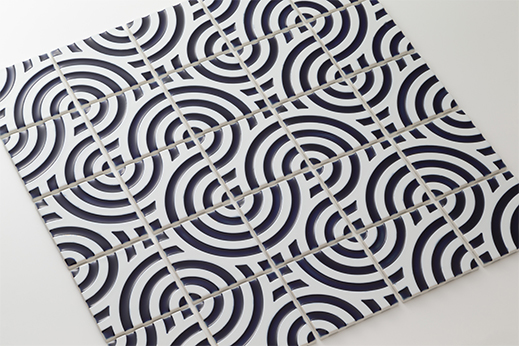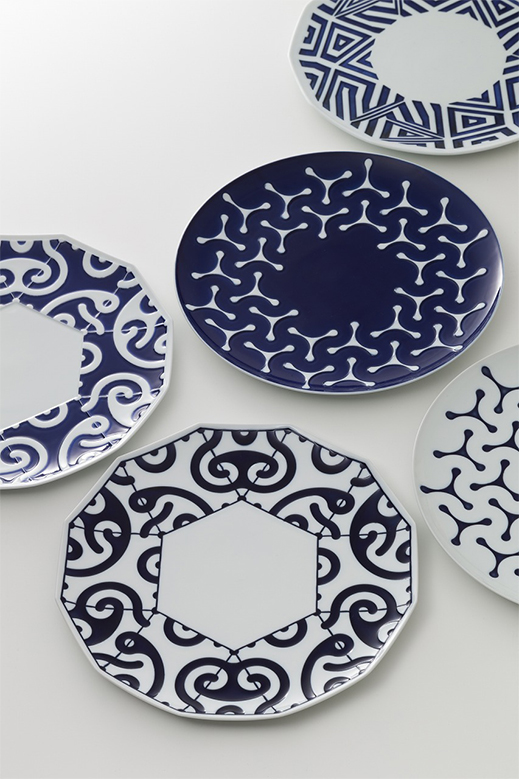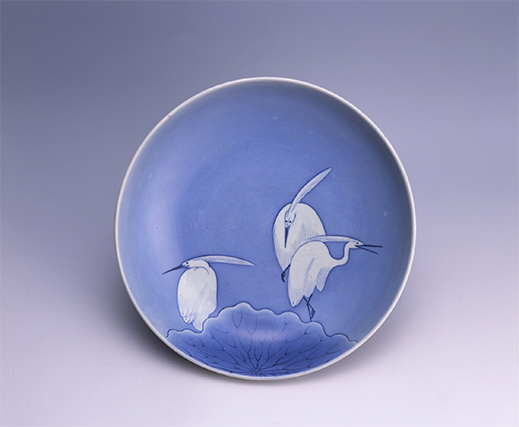 |
Focus features two in-depth reviews each month of fine art, architecture and design exhibitions and events at art museums, galleries and alternative spaces around Japan. The contributors are non-Japanese residents of Japan. |
|
|
 |
 |
 |
Asao Tokolo: A New Spin for Arita
Alice Gordenker |
 |
Centrifugal force dish (2019), designed by Asao Tokolo and produced in Arita, the birthplace of Japanese porcelain. |
Millions of people around the world have seen the work of Asao Tokolo, yet few would be able to produce his name or identify a single project to which he's contributed. Tokolo -- and that's the spelling he prefers for a surname usually romanized as "Tokoro" -- is the man behind the distinctive indigo checkered emblems for the Tokyo 2020 Olympic and Paralympic Games. Now, in a special solo exhibition opening this month at the Kyushu Ceramic Museum in Arita, Saga Prefecture, he's dishing up similar designs in blue and white that may point the way to new directions in Japanese porcelain.
|
 |
|
|
|
Asao Tokolo at the press conference announcing the selection of his designs as the winning emblems for the Tokyo 2020 Olympics and Paralympics. Photo by Tokyo 2020/Uta Mukuo
|
A native of Tokyo, Tokolo graduated in 1992 from Tokyo Zokei University, where he studied architecture. After apprenticing for several years with sculptor and artist Shin Egashira, Tokolo set up his own workshop in 2001, producing designs on the theme of tsunageru, meaning to link, most often using geometric shapes and curved lines that can be connected in many different ways. Tokolo created some of the key visuals used in Toyota's pavilion at the Aichi Expo in 2005. His patterns have also graced carpets, clothing, Issey Miyake bags, and the facades of buildings, including the Ftown Building in Sendai (2008, Atelier Hitoshi Abe) and Kokugakuin University's 125th Anniversary Education Center in Hachioji, Tokyo (2012, Chiba Manabu Architects). Tokolo was one of about two dozen artists whose works were showcased in the Measuring exhibition at 21_21 Design Sight in Tokyo in 2015.
Despite involvement in such high-profile projects, Tokolo was largely unknown until April 2016, when his Olympic designs were adopted by Tokyo 2020 after the original logo by Kenjiro Sano was scrapped amid accusations of plagiarism. Tokolo's winning designs are deceptively simple, composed of three rectangular forms turned and repeated in a mathematical sequence to form a circle (for the symbol of the Olympic games) and a U-shaped wreath (for the Paralympic logo). The pattern used in both references a traditional Japanese checkered design called ichimatsu that became popular during the Edo period (1603-1867), and is rendered in the deep indigo blue that was prevalent in clothing, art and dishes of that time.
 |
|
PPP Tokolo Tiles (2019), made in Arita for the exhibition. PPP stands for "Piecing Pieces Pattern." |
Tokolo's first visit to Arita, one of the world's most famous ceramic centers and the first place in Japan where porcelain was successfully fired, was in 2016 at the invitation of Gurunavi Inc., an online provider of restaurant information. The company asked Tokolo to design dishes to be presented as commemorative gifts to winners in a restaurant competition. In a recent interview, Tokolo recalled that the assignment initially felt intimidating -- "it was my first time to work with something that would break if dropped" -- but presented welcome new challenges. "After so many years of working with square canvases, whether paper or rooms or buildings, it was interesting to explore the circle as my format. And with ceramics, you don't know what you get until a piece has been fired, which adds an element of the unknown." Soon after that experience, Tokolo met Yukio Suzuta, director of the Kyushu Ceramic Museum, who proposed an exhibition to fuse the artist's unique perspective with local traditions in hopes of spurring innovation.
|
 |
|
|
|
Anniversary Gift "The Dish of the Year" (2016-2018), designed by Tokolo for Gurunavi Research Institute Inc.
|
The Kyushu Ceramic Museum was founded in 1980 by the Saga prefectural government, charged with the twin goals of preserving and promoting ceramics both as art and as a key local industry. In addition to research and educational activities, the museum offers excellent permanent exhibits on the history of ceramics in Kyushu, particularly those of the Hizen region, which includes Karatsu, Arita and Nabeshima ware. It also houses several remarkable collections donated to the museum by prominent collectors. A display drawn from the Kanbara Collection of Arita ware exported to Europe during the 17th and 18th centuries is great fun, demonstrating -- with pieces ranging from spittoons to shaving bowls and chandeliers -- the agility with which Arita potteries once responded to the demands of unfamiliar markets in faraway lands. One of the museum's greatest draws is the Shibata Collection -- over 10,000 pieces of Edo-era porcelain made for the domestic market. A large gallery on the museum's lower level is given over entirely to this collection, remarkable as much for its quality and breadth as its size, with approximately 1,000 pieces on display at any one time. Exhibits in this gallery are changed every December, and catalogs of the Shibata Collection are sought after by porcelain collectors around the world.
The museum also has permanent exhibits of modern ceramics, including works by prominent Kyushu potters, and regularly hosts traveling exhibitions of works selected in contemporary competitions. But the upcoming collaboration with Tokolo, titled Arita x Tokolo, is the first time the museum has invited a single guest artist to do an exhibition.
The first part of the show is devoted to works newly designed by Tokolo and produced in Arita, in which he explores shape, pattern and color. He delves particularly into the color blue, which in Arita ceramics can be produced with cobalt-based glazes known as sometsuke and ruri. To help others visualize the huge range of shades possible, Tokolo asked his kiln partner to mix up glazes with increasing concentrations of cobalt to produce 100 porcelain cubes in graduated shades, ranging from the slightest hint of color to the darkest night. He also experimented extensively with dropping glaze onto a dish as it revolves on a turntable, allowing centrifugal force to draw the color outwards and create intriguing patterns. "It seems an obvious design choice for round dishes in an environment already using wheels and turntables, but as far as I can tell centrifugal force has not previously been used in Arita to apply decoration. And while it may look simple and random, it is possible to achieve specific effects reliably through the careful control of glaze application."
 |
|
Three-footed dish with herons, made in the official Nabeshima domain kiln near Arita c. 1690-1710. Important Cultural Property, The Kyushu Ceramic Museum |
Dish with ichimatsu checkered pattern in underglaze blue, made in Arita c. 1720-1740. Shibata Collection, The Kyushu Ceramic Museum |
The second half of the exhibition is drawn, in consultation with Tokolo, from the museum's extensive collections of Edo-era porcelain. Tokolo looked to these old works for new inspiration, selecting pieces with design elements he judged will speak to modern audiences. As examples, he points to simple and humorous outlines of children and men, and a charming trio of herons. A surprising standout in this section is a dish with a checkered ichimatsu pattern that looks infinitely modern but in fact dates from the first half of the 18th century.
Those with a strong interest in Edo-era porcelain may wish to time their visit for a few weeks after the Tokolo show opens, as the museum will also offer a nearly concurrent exhibition of 101 choice pieces from its newly acquired Imaizumi Collection. Opening on 5 October, it will showcase porcelain made in Arita and environs during the 17th to 19th centuries, collected by Kichiro Imaizumi and his son Yoshihiro and donated to the museum last year. The upcoming show will include a round dish that was recently designated an Important Cultural Property, dating from around 1660 to 1690 and featuring an unusual design in underglaze blue of two birds in a freely brushed landscape.
Images courtesy of The Kyushu Ceramic Museum unless otherwise noted. |
 |
| Arita x Tokolo Exhibition |
| 20 September - 24 November 2019 |
| The Kyushu Ceramic Museum |
3100-1 Toshaku-Otsu, Arita, Saga Prefecture
Phone: 0955-43-3681
Hours: 9 a.m. to 5 p.m. (admission until 4:30 p.m.); closed Monday (or the following Tuesday when Monday is a national holiday) and 29-31 December. The museum is open during the New Year holidays, 1-3 January.
Access: Nagasaki is the closest airport but Arita can also be accessed from Saga and Fukuoka airports. The museum is a 12-minute walk from Arita Station on the JR Sasebo Line and the Matsuura Railway's Nishi-Kyushu Line, or a 10-minute drive from the Hasami Arita interchange of the Nishi-Kyushu Expressway.
|
|
 |
 |
Alice Gordenker
Alice Gordenker is a writer and translator based in Tokyo, where she has lived for more than 20 years. For over a decade, she penned the "So, What the Heck Is That?" column for The Japan Times, providing in-depth reports on everything from industrial safety to traditional talismans. She translates and consults for museums, and has a special interest in making Japanese museums more accessible for visitors from other countries. |
|
 |
|